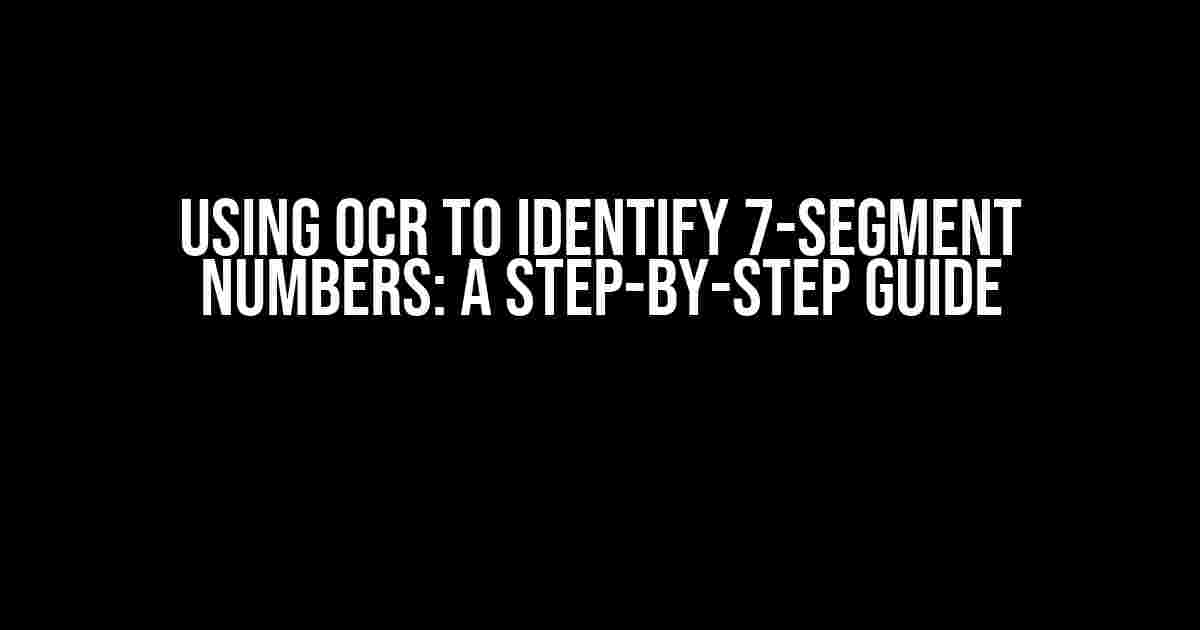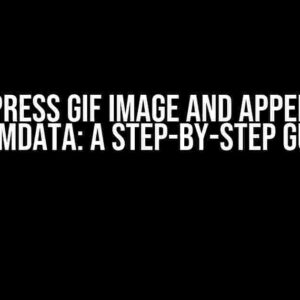Have you ever found yourself stuck in a situation where you need to extract 7-segment numbers from an image or scanned document, but don’t know where to start? Well, worry no more! In this comprehensive guide, we’ll walk you through the process of using OCR (Optical Character Recognition) to identify 7-segment numbers with ease.
What are 7-Segment Numbers?
Before we dive into the world of OCR, let’s quickly cover what 7-segment numbers are. A 7-segment display is a type of electronic display that uses seven individual segments to display numerical digits. These displays are commonly used in digital clocks, calculators, and other electronic devices.
Why Use OCR for 7-Segment Numbers?
So, why would you want to use OCR to identify 7-segment numbers? Well, here are a few reasons:
- Efficiency: Manual data entry can be a tedious and time-consuming task, especially when dealing with large datasets. OCR technology can automate the process, saving you hours of manual labor.
- Accuracy: Humans are prone to errors, especially when dealing with large datasets. OCR technology can reduce the risk of human error, providing more accurate results.
- Scalability: As datasets grow, manual data entry becomes increasingly difficult. OCR technology can handle large datasets with ease, making it an ideal solution for scaling your operations.
Choosing the Right OCR Tool
Before we dive into the step-by-step process, it’s essential to choose the right OCR tool for the job. There are many OCR tools available, both online and offline. Here are a few popular options:
- Tesseract OCR: An open-source OCR engine developed by Google. It’s highly accurate and supports over 100 languages.
- Adobe Acrobat: A popular PDF editor that includes OCR capabilities. It’s user-friendly and produces high-quality results.
- Online OCR Tools: There are many online OCR tools available, such as OCR.space, Online OCR, and Readiris. These tools are convenient and often free, but may have limitations on file size and quality.
Step-by-Step Guide to Using OCR for 7-Segment Numbers
Now that you’ve chosen your OCR tool, it’s time to start the process. Follow these steps to identify 7-segment numbers using OCR:
Step 1: Prepare Your Image
The quality of your input image plays a significant role in the accuracy of the OCR results. Here are a few tips to prepare your image:
- High-Contrast: Ensure the 7-segment display is clear and has high contrast between the digits and the background.
- Resolution: Use a high-resolution image (at least 300 DPI) to ensure the OCR tool can accurately recognize the digits.
- Noise Reduction: Remove any noise or artifacts from the image using image editing software.
Step 2: Pre-Process the Image
Before feeding the image into the OCR tool, it’s essential to pre-process the image to enhance the quality. Here’s an example using ImageMagick:
convert input_image.png -threshold 50% -deskew 40% output_image.png
This code converts the input image to a binary image using the threshold filter, and then deskews the image by 40% to straighten the digits.
Step 3: Run the OCR Tool
Now it’s time to run the OCR tool on your pre-processed image. Here’s an example using Tesseract OCR:
tesseract output_image.png output_text.txt -c tessedit_char_whitelist=0123456789
This code runs the Tesseract OCR engine on the pre-processed image, outputting the recognized text to a file named output_text.txt. The -c tessedit_char_whitelist=0123456789 flag tells Tesseract to only recognize digits (0-9).
Step 4: Post-Process the Output
The OCR tool may produce some errors or inaccuracies, so it’s essential to post-process the output. Here’s an example using Python:
import re
with open('output_text.txt', 'r') as f:
text = f.read()
# Remove any non-digit characters
text = re.sub(r'[^0-9]', '', text)
# Split the text into individual digits
digits = [int(d) for d in text]
print(digits)
This code reads the output text file, removes any non-digit characters, and splits the text into individual digits. The resulting list of digits can be used for further processing or analysis.
Common Issues and Solutions
Like any technology, OCR is not perfect, and you may encounter some issues. Here are some common issues and solutions:
Issue 1: Poor Image Quality
Solution: Improve the image quality by adjusting the contrast, brightness, and resolution. You can also try applying filters to enhance the image.
Issue 2: OCR Inaccuracy
Solution: Adjust the OCR tool’s settings, such as the language, font, and character whitelist. You can also try pre-processing the image further or using a different OCR tool.
Issue 3: Digit Misrecognition
Solution: Use a more advanced OCR tool or apply additional processing to the output, such as using a spell checker or dictionary to correct errors.
Conclusion
Using OCR to identify 7-segment numbers can be a powerful tool in your data extraction arsenal. By following these steps and choosing the right OCR tool, you can accurately extract 7-segment numbers from images and scanned documents. Remember to prepare your image, pre-process it, run the OCR tool, and post-process the output to achieve the best results.
Additional Resources
Want to learn more about OCR and 7-segment numbers? Here are some additional resources:
- Tesseract OCR Documentation: A comprehensive guide to using Tesseract OCR, including settings, parameters, and advanced features.
- 7-Segment Display Wiki: A detailed wiki covering the history, design, and applications of 7-segment displays.
- OCR Tutorial Series: A series of tutorials covering the basics of OCR, including image pre-processing, OCR engines, and post-processing techniques.
Final Thoughts
Using OCR to identify 7-segment numbers is a powerful technique that can save you time and increase accuracy. By following this guide and experimenting with different OCR tools and techniques, you can unlock the full potential of OCR and take your data extraction to the next level.
| OCR Tool | Accuracy | Speed | Language Support |
|---|---|---|---|
| Tesseract OCR | High | Fast | 100+ languages |
| Adobe Acrobat | High | Fast | 20+ languages |
| Online OCR Tools | Varying | Varies | Varying language support |
This table compares the accuracy, speed, and language support of popular OCR tools. Remember to choose the right tool for your specific use case.
Frequently Asked Question
Got questions about using OCR to identify 7-segment numbers? We’ve got answers!
What is OCR and how does it help with 7-segment number recognition?
OCR, or Optical Character Recognition, is a technology that enables computers to recognize and extract text from images. In the context of 7-segment number recognition, OCR plays a crucial role in identifying the digits displayed on an LCD or LED screen. By using OCR, you can automate the process of reading numbers from an image, making it faster and more accurate than manual data entry.
What kind of images can be used for 7-segment OCR?
Any image containing a 7-segment display can be used for OCR, including photos of LCD or LED screens, scanned documents, or even screenshots. The quality of the image affects the accuracy of the OCR results, so it’s essential to ensure the image is clear, well-lit, and has a high enough resolution.
How accurate is 7-segment OCR?
The accuracy of 7-segment OCR depends on various factors, including the quality of the image, the complexity of the 7-segment font, and the OCR engine used. Generally, modern OCR engines can achieve high accuracy rates, often above 95%, when the image quality is good. However, in cases where the image is blurry, distorted, or contains noise, the accuracy may be lower.
Can I use 7-segment OCR for real-time applications?
Yes, 7-segment OCR can be used in real-time applications, such as reading numbers from a display in a dashboard or a gauge. This is possible when the OCR engine is integrated with a camera or image capture device and can process images quickly. Real-time OCR enables applications like automated meter reading, machine vision inspection, and IoT data collection.
What are some common challenges in 7-segment OCR?
Some common challenges in 7-segment OCR include varying font styles, orientations, and sizes, as well as image noise, blur, or distortion. Additionally, 7-segment displays can have similar-looking digits (e.g., 1 and I), which can lead to recognition errors. To overcome these challenges, it’s essential to preprocess the images, use a robust OCR engine, and fine-tune the recognition algorithms for the specific 7-segment font and application.


